Volga Bulgaria
Volga Bulgaria or Volga–Kama Bulgaria was a historical Bulgar[1][2][3] state that existed between the 7th and 13th centuries around the confluence of the Volga and Kama River, in what is now European Russia. Volga Bulgaria was a multi-ethnic state with large numbers of Bulgars, Volga Finns, Varangians and many East Slavs.[4] Its strategic position allowed it to create a local trade monopoly with Norse, Cumans, and Pannonian Avars.[5]
Volga Bulgaria | |||||||||
|---|---|---|---|---|---|---|---|---|---|
| late 7th century–1240s | |||||||||
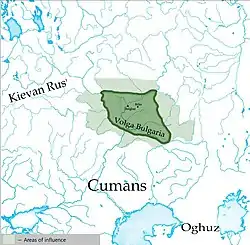 | |||||||||
| Capital | Bolghar Bilär | ||||||||
| Common languages | Bulgar | ||||||||
| Religion | Tengrism, later Sunni Islam (after Almish Iltäbär) | ||||||||
| Government | Monarchy | ||||||||
| Ruler | |||||||||
• 9th century | Şilki | ||||||||
• 10th century | Almış, Ahmad, Mikaʾil, Abdallah, Talib, Muʾmin I, Muʾmin II, Shamgun | ||||||||
• 11th-13th centuries | Khaidar, Mukhammad, Saʾid, Baradz, Ibrahim, Otyak, Ghabdula Chelbir, Ilham Khan | ||||||||
| Historical era | Middle Ages | ||||||||
• Established | late 7th century | ||||||||
• Conversion to Islam | 922 | ||||||||
| 1240s | |||||||||
| |||||||||
| Today part of | Russia | ||||||||
History
Origin and creation of the state
The origin of the early Bulgars is still unclear. Their homeland is believed to be situated between Kazakhstan and the North Caucasian steppes. Interaction with the Hunnic tribes, causing the migration, may have occurred there, and the Pontic steppe seems the most likely location.[6]
Some scholars propose that the Bulgars may have been a branch or offshoot of the Huns or at least Huns seem to have been absorbed by the Bulgars after Dengizich's death.[7] Others however, argue that the Huns continued under Ernak, becoming the Kutrigur and Utigur Hunno-Bulgars.[8] These conclusions remain a topic of ongoing debate and controversy among scholars.
The Bulgars were an Oghuric people[9][10] who settled north of the Black Sea. During their westward migration across the Eurasian steppe, they came under the overlordship of Khazars, leading other ethnic groups, including Finnic and Iranic as well as other Turkic peoples.[9] In about 630 they founded Old Great Bulgaria, which was destroyed by the Khazars in 668. Kubrat's son and appointed heir, Batbayan Bezmer, moved east from the Azov region in about AD 665, commanded by the Kazarig Khagan Kotrag, to whom he had surrendered. They reached Idel-Ural in the eighth century, where they became the dominant population at the end of the 9th century, uniting other tribes of different origin who lived in the area.[11]
Some Bulgar tribes, however, returned westward and eventually settled along the Danube River, in what is now known as Bulgaria proper, where they created a confederation with the Slavs, adopting a South Slavic language and the Eastern Orthodox faith. However, Bulgars in Idel-Ural eventually gave birth to Chuvash people. Unlike Danube Bulgars, Volga Bulgars did not adopt any language. The Chuvash language today is the only Oghuric language that survived and it is the sole living representative of the Volga Bulgar language.[12][13][14][15]
Most scholars agree that the Volga Bulgars were initially subject to the Khazar Khaganate. This fragmented Volga Bulgaria grew in size and power and gradually freed itself from the influence of the Khazars. Sometime in the late 9th century, unification processes started and the capital was established at Bolghar (also spelled Bulgar) city, 160 km south of modern Kazan. However, complete independence was reached after Khazaria's destruction and conquest by Sviatoslav in the late 10th century; thus, Bulgars no longer paid tribute to it.[16][17] Abu al-Ghazi Bahadur named the Volga Bulgar people as Ulak.[18]
Conversion to Islam and further statehood
Volga Bulgaria adopted Islam in 922 – 66 years before the Christianization of Kievan Rus'. In 921 Almış sent an ambassador to the Caliph requesting religious instruction. Next year an embassy returned with Ibn Fadlan as secretary. A significant number of Muslims already lived in the country.[19]
The Volga Bulgars attempted to convert Vladimir I of Kiev to Islam; however Vladimir rejected the notion of Rus' giving up wine, which he declared was the "very joy of their lives".[20]
Commanding the Volga River in its middle course, the state controlled much of trade between Europe and Asia prior to the Crusades (which made other trade routes practicable). The capital, Bolghar, was a thriving city, rivalling in size and wealth the greatest centres of the Islamic world. Trade partners of Bolghar included from Vikings, Bjarmland, Yugra and Nenets in the north to Baghdad and Constantinople in the south, from Western Europe to China in the East. Other major cities included Bilär, Suar (Suwar), Qaşan (Kashan) and Cükätaw (Juketau). Modern cities Kazan and Yelabuga were founded as Volga Bulgaria's border fortresses. Some of the Volga Bulgarian cities have still not been found, but they are mentioned in old East Slavic sources. They are: Ashli (Oshel), Tuxçin (Tukhchin), İbrahim (Bryakhimov), Taw İle. Some of them were ruined during and after the Golden Horde invasion.
The Rus' principalities to the west posed the only tangible military threat. In the 11th century, the country was devastated by several raids by other Rus'. Then, at the turn of the 12th and 13th centuries, the rulers of Vladimir (notably Andrew the Pious and Vsevolod III), anxious to defend their eastern border, systematically pillaged Volga Bulgarian cities. Under Rus' pressure from the west, the Volga Bulgars had to move their capital from Bolghar to Bilär.
Decline
In September 1223 near Samara an advance guard of Genghis Khan's army under command of Uran, son of Subutai Bahadur, entered Volga Bulgaria but was defeated in the Battle of Samara Bend. In 1236, the Mongols returned and in five years had subjugated the whole country, which at that time was suffering from internal war . Henceforth Volga Bulgaria became a part of the Ulus Jochi, later known as the Golden Horde. It was divided into several principalities; each of them became a vassal of the Golden Horde and received some autonomy. By the 1430s, the Khanate of Kazan was established as the most important of these principalities.
Language
Volga Bulgar language was an Oghuric language. The only extant member of the Oghuric group is the Chuvash language. Language persisted in Volga region until the 13th or 14th century, and it is eventually gave rise to Chuvash language and which is classified as living representative of Volga Bulgar language.[12][13][14][15]
Italian historian and philologist Igor de Rachewiltz noted a significant distinction of the Chuvash-Bulgar language from other Turkic languages. According to him, the Chuvash language does not share certain common characteristics with Turkic languages to such a degree that some scholars consider it an independent Onoguric (Bulgharic) family similiar to Uralic and Turkic languages. Turkic classification of Chuvash-Bulgar was seen as a compromise solution for the classification purposes.[21]
Definition of verbs in Volga Bulgar[22][23]
| Tenses and moods | Volga Bulgar | Examples in words |
|---|---|---|
| Past tense | -ti/tı, -ri/rı | وَلتِ (vel-ti) |
| Past tense 2 | -ruvı/rüvi (<*-dugı), -tuvı/tüvi (<*-tugı) | كُوَجڔوُي (küveč-rüvi), بلطُوى (bal-tuvı) |
| Adjective form of verb | -an/en | طَنَان (tan-an), سَوَان (sev-en) |
| Adverb form of verb | -sa/se | بَرسَ (bar-sa) |
| Third person imperative | -tur/tür | طَنْطُرْ (tan-tur) |
Volga Bulgars left some inscriptions in tombstones. There are few surviving inscriptions in the Volga Bulgar language, as the language was primarily an oral language and the Volga Bulgars did not develop a writing system until much later in their history.[24] After converting to Islam, some of these inscriptions were written using Arabic letters while the use of the Orkhon script continued. Mahmud al-Kashgari provides some information about the language of the Volga Bulgars, whom he refers to as Bulghars. Some scholars suggest Hunnic had strong ties with Bulgar and to modern Chuvash[25] and classify this grouping as separate Hunno-Bulgar languages.[26]
Numbers and Vocabulary in Volga Bulgar[23][22][27][28][29][30][31]
| Volga Bulgar[32][33][27] | Chuvash[34] | Oghuric | |
|---|---|---|---|
| one | بر (bir) | пӗр (pĕr) | *bīr |
| two | اک (eki) | иккӗ (ikkĕ) | *ẹki |
| three | وج (več) | виççӗ (viççĕ) | *üč |
| four | تُوات (tüvet) | тăваттă (tăvattă) | *tȫrt |
| five | بل (bel), بيال (biyel) | пиллӗк (pillĕk) | *bẹ̄ĺ(k) |
| six | اَلطِ (altï) | улттӑ (ulttă) | *altï |
| seven | جىَاتِ (cyeti) | ҫиччӗ (śiččĕ) | *yẹti |
| eight | ڛَكِڔ (sekir) | саккӑр (sakkăr) | *sekiŕ |
| nine | طُخِڔ (tuxïr) | тӑххӑр (tăhhăr) | *tokuŕ |
| ten | وان (van) | вуннӑ (vunnă) | *ōn |
| twenty | جِيِرم (ciyirim) | ҫирӗм (śirĕm) | *yẹgirmi |
| thirty | وطر (vutur) | вӑтӑр (văt̬ăr) | *otuŕ |
| forty | حرح (xïrïx) | хӗрӗх (hĕrĕh) | *kïrk |
| fifty | الو (ellü) | аллӑ (allă) | *ellig |
| hundred | جُور (cǖr) | ҫӗр (śĕr) | *yǖŕ |
Mahmud al-Kashgari also provides some examples of Volga Bulgar words, poems, and phrases in his dictionary.. However, Mahmud al-Kashgari himself wasn't a native speaker of Volga Bulgar. Despite its limitations, Mahmud al-Kashgari's work remains an important source of information about the Volga Bulgar language and its place within the broader Turkic language family.
| Case | Volga Bulgar | Examples in words |
|---|---|---|
| Genitive | -∅ or -(ı)n | اَغَان (ağā-n), يغقوُتن (yaquut-ın) |
| Accusative | -ne/na | مَسجِذڛَمنَ (mesčidsem-ne) |
| Dative-locative | -a/e and -ne/na | اِشنَ (iš-ne), بَجنَ (bač-na), جَالَ (čāl-a) |
| Ablative | -ran, -ren; -tan, -ten | ڊنيَاڔَان (dönyā-ran) |
| Third person possessive | -i, -ı; -si, -sı | هِيرِ (hīr-i), اِلغِجِڛِ (ılğıčı-sı) |
Coats of arms of Volga Bulgaria during Tsarist Russia
Ivan III was also called the "Prince of Bulgaria". The mention of the Bulgarian land has been present in the royal title since 1490. This refers to Volga Bulgaria.
Ivan by the grace of God is the sovereign of all Russia and the Grand Duke of Vladimir, and Moscow, and Novgorod, and Pskov, and Tver, and Yugra, and Prmsk, and Bolgar and others[35]
It is known that the Bulgarian coat of arms figure was used to designate the Bulgarian Kingdom and in the Great Seal of Tsar John IV. The seal was a "lion walking" (which is confirmed by the seals of the Volga Bulgarians found by archaeologists). On the coats of arms and seals of the Russian tsars, the lands of Volga Bulgaria were represented on a green field by a silver walking lamb with a red banner divided by a silver cross; the shaft is gold.[36] The erroneous perception of the beast on the Bulgarian coat of Arms in the Royal Titular as a lamb is explained by the poor quality of the reproduction of the image. In the "Historical Dictionary of Russian Sovereigns ..." by I. Nekhachin (ed. by A.Reshetnikov, 1793), the Bulgarian coat of arms is described as follows: "Bulgarian, in a blue field, a silver lamb wearing a red banner." Over time, the colour of the shield changed to green. In the Manifesto on the full coat of arms of the Empire (1800), the Bulgarian coat of arms is described as follows: "In a green field it has a white Lamb with a golden radiance near its head; in its right front paw it holds a Christian banner." The description of the coat of arms, approved in 1857: "The Bulgarian coat of arms: a silver lamb walking in a green field, with a scarlet banner, on which the cross is also silver; the shaft is gold."
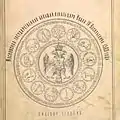 Coat of arms of the Volga Bulgars on the great state seal of Ivan IV Grozny
Coat of arms of the Volga Bulgars on the great state seal of Ivan IV Grozny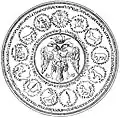 Coat of arms of the Volga Bulgars on the great state seal of Ivan IV Grozny
Coat of arms of the Volga Bulgars on the great state seal of Ivan IV Grozny.gif) Bulgarian Seal from the Great Seal of Ivan Grozny
Bulgarian Seal from the Great Seal of Ivan Grozny Coat of arms of Volga Bulgaria 1672
Coat of arms of Volga Bulgaria 1672 Coat of arms of the Volga Bulgars. Tatarnikov K.V. Banners and coats of arms of the regiments of the Russian Army of the reigns of Catherine I and Peter II (1725-1730)
Coat of arms of the Volga Bulgars. Tatarnikov K.V. Banners and coats of arms of the regiments of the Russian Army of the reigns of Catherine I and Peter II (1725-1730) Coat of Arms of Bulgaria 1857
Coat of Arms of Bulgaria 1857_%D0%91%D0%BE%D0%BB%D0%B3%D0%B0%D1%80%D1%81%D0%BA%D0%B8%D0%B9_(1857).gif) Coat of Arms of Bulgaria 1857
Coat of Arms of Bulgaria 1857 Coat of Arms of Volga Bulgaria
Coat of Arms of Volga Bulgaria.gif) Coat of arms of Volga Bulgaria 1626
Coat of arms of Volga Bulgaria 1626 Upper right corner coat of arms of Volga Bulgaria
Upper right corner coat of arms of Volga Bulgaria Coat of arms of Volga Bulgaria 1714
Coat of arms of Volga Bulgaria 1714
Demographics
A large part of the region's population included Turkic groups such as Sabirs, Esegel, Barsil, Bilars, Baranjars and part of the obscure[37] Burtas (by ibn Rustah). Modern Chuvashes claim to descend from Sabirs, Esegel and Volga Bulgars.[38]
Another part comprised Volga Finnic and Magyar (Asagel and Pascatir) tribes, from which Bisermäns probably descend.[39] Ibn Fadlan refers to Volga Bulgaria as Saqaliba, a general Arabic term for Slavic people. Other researches tie the term to the ethnic name Scythian (or Saka in Persian).[40]
According to some historians, over 80% of the country's population was killed during the invasion. The remaining population mostly relocated to the northern areas (territories of modern Chuvashia and Tatarstan). Some autonomous duchies appeared in those areas.
Over time, the cities of Volga Bulgaria were rebuilt and became trade and craft centres of the Golden Horde. Some Volga Bulgars, primarily masters and craftsmen, were forcibly moved to Sarai and other southern cities of the Golden Horde. Volga Bulgaria remained a centre of agriculture and handicraft.
Gallery
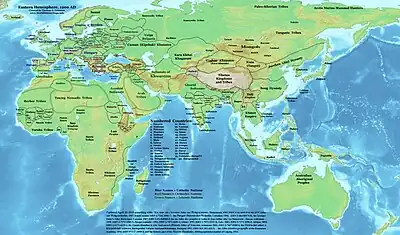 Volga Bulgaria in the Eurasian world of AD 1200
Volga Bulgaria in the Eurasian world of AD 1200 Adzes, Volga Bulgaria, 13-14 century
Adzes, Volga Bulgaria, 13-14 century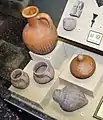 Pottery of Volga Bulgaria, 10-14 century
Pottery of Volga Bulgaria, 10-14 century Necklaces, Volga Bulgaria, 10-14 century
Necklaces, Volga Bulgaria, 10-14 century
See also
References
- Shpakovsky, Viacheslav; Nicolle, David (2013). Armies of the Volga Bulgars & Khanate of Kazan. p. 14.
- Champion, Timothy (2014). Nationalism and Archaeology in Europe. p. 227.
- Koesel, Karrie J. (2014). Religion and Authoritarianism: Cooperation, Conflict, and the Consequences. p. 103.
- The New Cambridge medieval history. McKitterick, Rosamond. Cambridge [England]: Cambridge University Press. 1995–2005. ISBN 9781139055727. OCLC 697957877.
{{cite book}}: CS1 maint: others (link) - Popovski, Ivan (2017-05-10). A Short History of South East Europe. Lulu Press, Inc. ISBN 9781365953941. Archived from the original on 2023-01-21. Retrieved 2020-10-03.
- Golden, Peter B. (1992). An Introduction to the History of the Turkic Peoples. p. 137.
- Maenchen-Helfen, Otto; Helfen, Otto (1973-01-01). The World of the Huns: Studies in Their History and Culture. University of California Press. p. 168. ISBN 978-0-520-01596-8.
- Kim, Hyun Jin (2013-04-18). The Huns, Rome and the Birth of Europe. 2013: Cambridge University Press. p. 123. ISBN 978-1-107-00906-6.
{{cite book}}: CS1 maint: location (link) - Golden 1992, p. 253, 256: "With their Avar and Türk political heritage, they assumed political leadership over an array of Turkic groups, Iranians and Finnic peoples, under the overlordship of the Khazars, whose vassals they remained." ... "The Bulgars, whose Oguric ancestors ..."
- Hyun Jin Kim (2013). The Huns, Rome and the Birth of Europe. Cambridge University Press. pp. 58–59, 150–155, 168, 204, 243. ISBN 9781107009066.
- "Болгарлар". Tatar Encyclopaedia (in Tatar). Kazan: The Republic of Tatarstan Academy of Sciences. Institution of the Tatar Encyclopaedia. 2002.
- Agyagási, K. (2020). "A Volga Bulgarian Classifier: A Historical and Areal Linguistic Study". University of Debrecen. 3: 9.
Modern Chuvash is the only descendant language of the Ogur branch.The ancestors of its speakers left the Khazar Empire in the 8th century and migrated to the region at the confluence of the Volga and Kama rivers, where they founded the Volga Bulgarian Empire in the 10th century. In the central Volga region three Volga Bulgarian dialects developed, and Chuvash is the descendant of the 3rd dialect of Volga Bulgarian (Agyagási 2019: 160–183). Sources refer to it as a separate language beginning with 1508
- Marcantonio, Angela (2002). The Uralic language family: facts, myths and statistics. Wiley-Blackwell. p. 167. ISBN 0-631-23170-6.
- Price, Glanville (2000). Encyclopedia of the languages of Europe. Wiley-Blackwell. p. 88. ISBN 0-631-22039-9.
- Clauson, Gerard (2002). Studies in Turkic and Mongolic linguistics. Taylor & Francis. p. 38. ISBN 0-415-29772-9.
- A History of Russia: Since 1855, Walter Moss, pg 29
- Shpakovsky, Viacheslav; Nicolle, David (2013). Armies of the Volga Bulgars & Khanate of Kazan: 9th–16th centuries. Bloomsbury Publishing. p. 10. ISBN 978-1-78200-080-8.
- Makkay, János (2008), "Siculica Hungarica De la Géza Nagy până la Gyula László" [Siculica Hungarica From Géza Nagy to Gyula László] (PDF), Acta Siculica: 209–240
- Azade-Ayse Rolich, The Volga Tatars, 1986, page 11. Richard Frye, Ibn Fadlan's Journey to Russia, 2005, page 44 gives 16 May 922 for the first meeting with the ruler. This seems to be the official date of the conversion.
- The preaching of Islam: a history of the propagation of the Muslim faith By Sir Thomas Walker Arnold, p. 201-202
- Rachewiltz, Igor de. Introduction to Altaic philology: Turkic, Mongolian, Manchu / by Igor de Rachewiltz and Volker Rybatzki; with the collaboration of Hung Chin-fu. p. cm. — (Handbook of Oriental Studies = Handbuch der Orientalistik. Section 8, Central Asia; 20). — Leiden; Boston, 2010. — P. 7.
- Tekin, Talât (1988). Volga Bulgar kitabeleri ve Volga Bulgarcası. Ankara: Türk Tarih Kurumu Basımevi. pp. 30–38. ISBN 978-9-751600-660.
- HAKIMZJANOV, F. S. “NEW VOLGA BULGARIAN INSCRIPTIONS.” Acta Orientalia Academiae Scientiarum Hungaricae, vol. 40, no. 1, Akadémiai Kiadó, 1986, pp. 173–77, .
- New Volga Bulgarian Inscriptions F. S. Hakimjanov
- Pritsak, Omeljan (1982). "The Hunnic Language of the Attila Clan". Harvard Ukrainian Studies. Cambridge, Massachusetts: Harvard Ukrainian Research Institute. IV (4): 470. ISSN 0363-5570. JSTOR 41036005.
The language had strong ties to Bulgar language and to modern Chuvash, but also had some important connections, especially lexical and morphological, to Ottoman Turkish and Yakut
- Pritsak, Omeljan (1981). "The Proto-Bulgarian Military Inventory Inscriptions". Turkic-Bulgarian-Hungarian relations. Budapest.
{{cite book}}: CS1 maint: location missing publisher (link) - A Volga Bulgarıan Inscription From 1307 A. Róna-tas
- Unpublished Volga Bulgarian inscriptions A. H. Khalikov and J. G. Muhametshin
- "Закиев М. З. Лингвоэтнические особенности волжских булгар — главного этнического корня татар". bulgarizdat.ru. Retrieved 2021-08-24.
- "Category:Bulgar numerals – Wiktionary". en.wiktionary.org. 31 July 2021. Retrieved 2021-08-24.
- "Proto-Turkic/History of Proto-Turkic language – Wikibooks, open books for an open world". en.wikibooks.org. Retrieved 2021-08-24.
- "Category:Bulgar numerals". 20 June 2022.
- "Лингвоэтнические особенности волжских булгар — главного этнического корня татар". 14 July 2022.
- "Numbers in Chuvash".
- Филюшкин А. И. (2006). Титулы русских государей (in Russian). Санкт Петербург: М.; СПб. p. 199.
- "Титульные гербы". www.heraldicum.ru.
- RUSSIAN: "По этнокультурному определению буртас в результате двухсотлетнего изучения сложилось множество точек зрения, которые можно объединить в 3 основные: тюркская, аланская и мордовская (наименее распространённая)." Буртасы//Ислам в центрально-европейской части России: энциклопедический словарь / Коллект. автор; сост. и отв. редактор Д. З. Хайретдинов. — М.: Издательский дом «Медина», 2009, С.55. ENGLISH: "According to the ethnocultural definition of Burtas, as a result of two hundred years of study, many points of view have developed that can be combined into 3 main ones: Turkic, Alanian and Mordovian (the least common)." Burtases//Islam in the Central European part of Russia: an encyclopedic dictionary / Collect. author; comp. and otv. editor D.Z. Khairetdinov. - M .: Publishing house "Medina", 2009, p. 55.
- "Volga Bulgaria". Chuvash Encyclopedia. Chuvash Institute of Humanities. Retrieved 20 October 2016.
- К вопросу о происхождении самоназвания бесермян УДМУРТОЛОГИЯ
- R. Frye, 2005. "Ibn Fadlan's journey to Russia"
External links
- Kropotkin, Peter Alexeivitch (1911). . Encyclopædia Britannica. Vol. 4 (11th ed.). p. 786.
- (in Russian) Bariev, R(iza) X. 2005. Волжские Булгары : история и культура (Volga Bulgars: History and Culture). Saint Petersburg: Agat.
